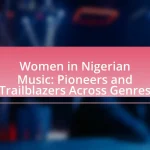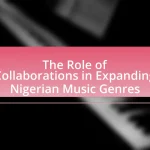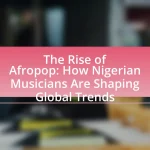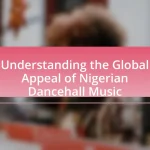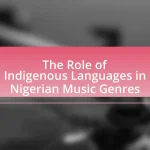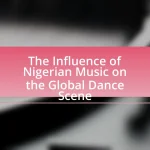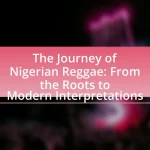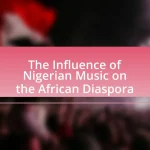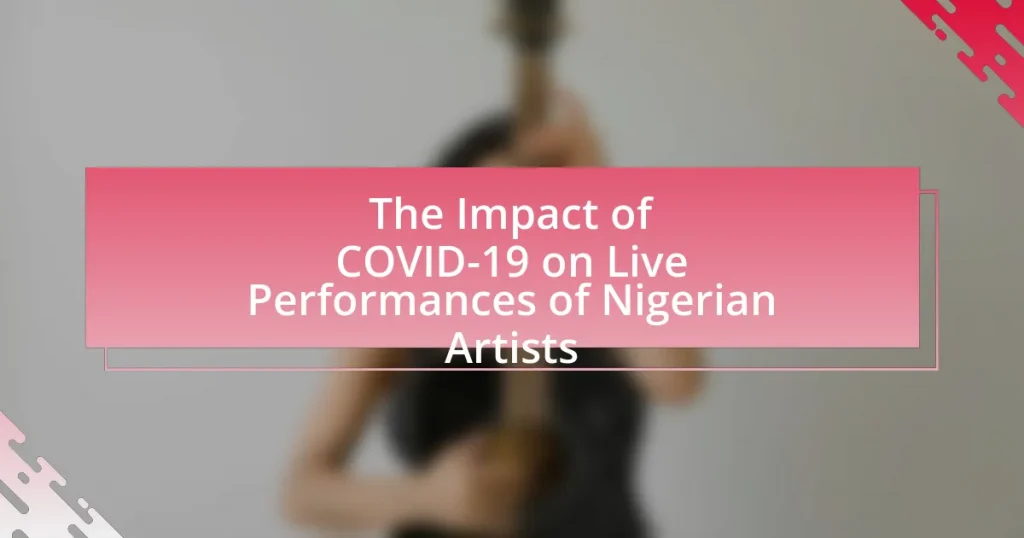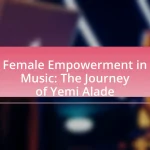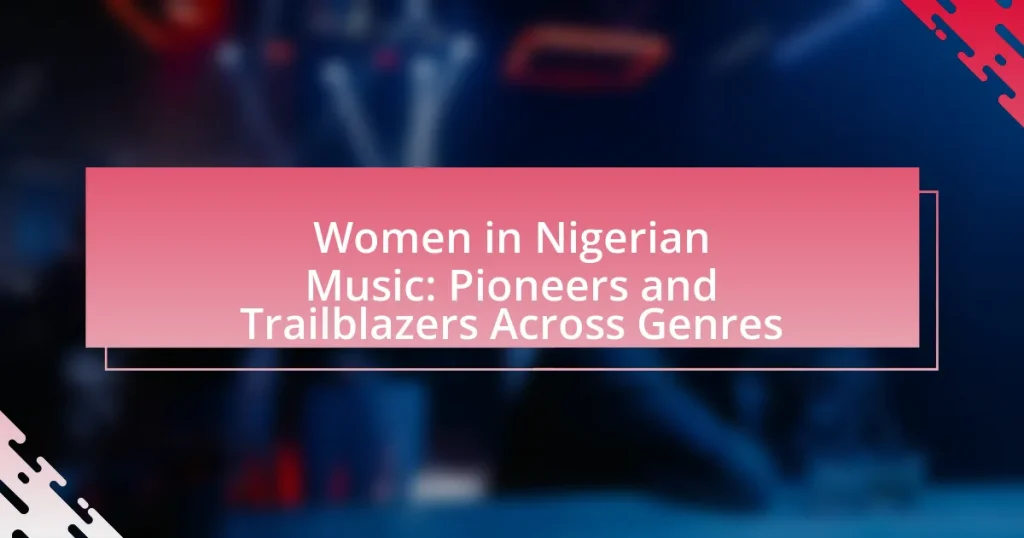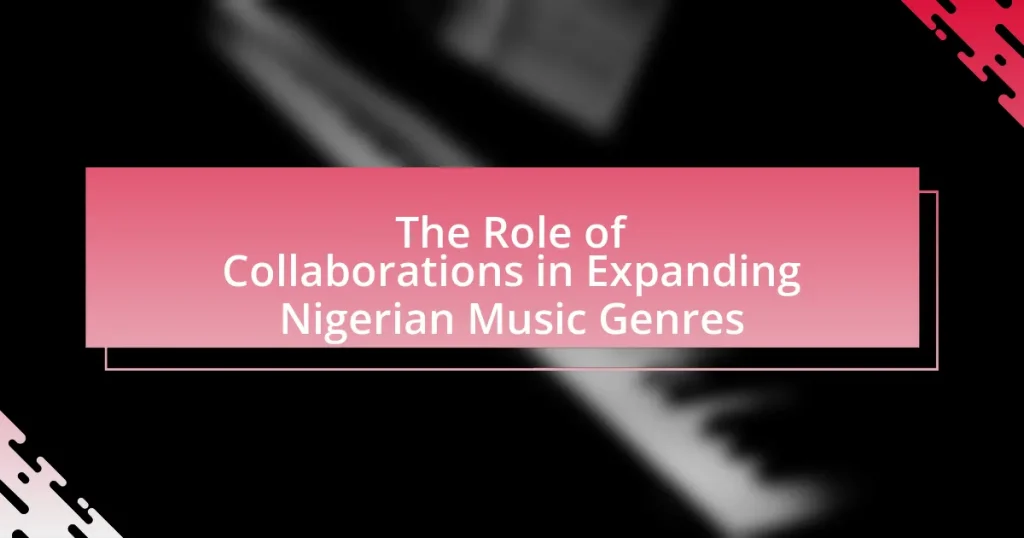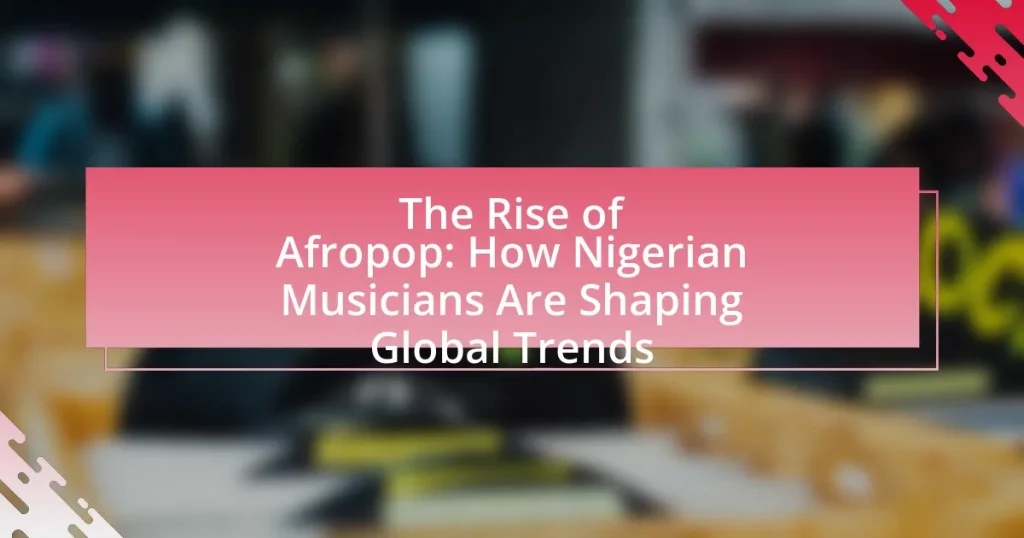The article examines the significant impact of COVID-19 on live performances by Nigerian artists, highlighting the widespread cancellations and the industry’s shift to virtual platforms. It details the financial losses incurred, with an estimated 1.2 trillion Naira lost in 2020, and discusses the immediate changes in performance schedules and venues due to government regulations. The article also addresses the challenges faced by artists, including income decline and mental health issues, while exploring their adaptations through online concerts and digital engagement. Furthermore, it analyzes the long-term changes in the industry, audience expectations, and strategies for future resilience in a post-pandemic world.
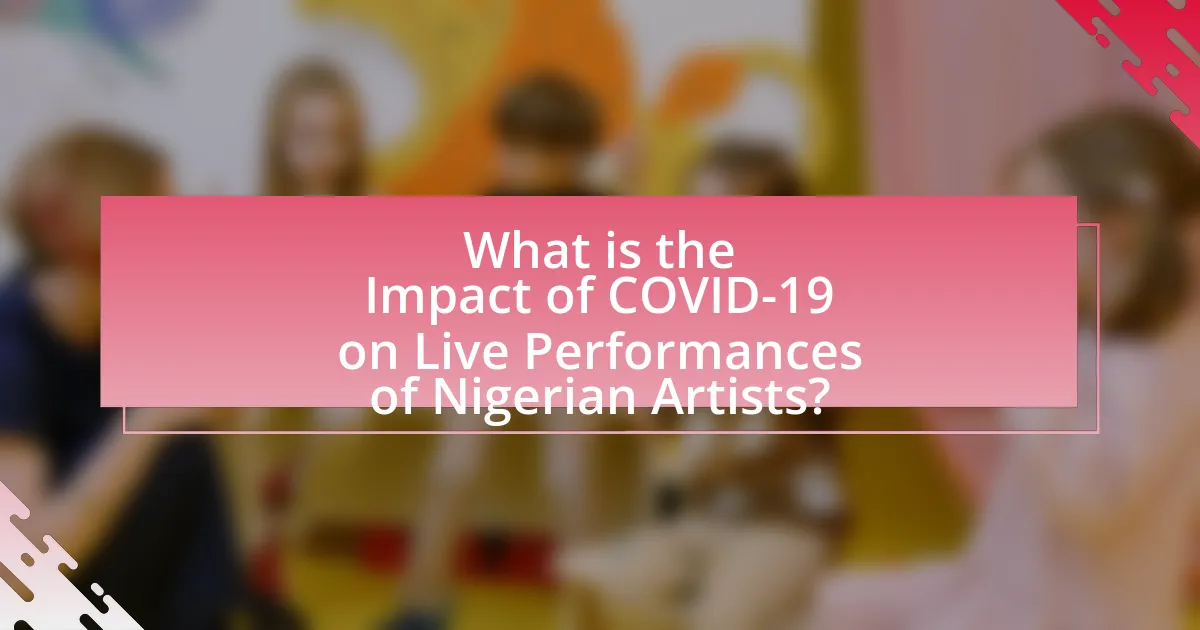
What is the Impact of COVID-19 on Live Performances of Nigerian Artists?
The impact of COVID-19 on live performances of Nigerian artists has been significant, leading to widespread cancellations and a shift to virtual platforms. In 2020, the Nigerian entertainment industry faced a loss of approximately 1.2 trillion Naira due to the pandemic, as live events were halted and social distancing measures were enforced. This disruption forced artists to adapt by embracing online concerts and digital engagement, which, while providing new opportunities, also highlighted the challenges of monetizing virtual performances compared to traditional live shows.
How did COVID-19 initially affect live performances in Nigeria?
COVID-19 initially led to the cancellation and postponement of live performances in Nigeria, significantly disrupting the entertainment industry. As the pandemic spread in early 2020, government restrictions on gatherings and social distancing measures forced artists and event organizers to halt concerts, festivals, and other live events. For instance, the Nigerian government announced a ban on public gatherings in March 2020, which directly impacted numerous scheduled performances and resulted in substantial financial losses for artists and venues.
What were the immediate changes in performance schedules and venues?
The immediate changes in performance schedules and venues for Nigerian artists due to COVID-19 included the cancellation or postponement of live events and a shift to virtual performances. Many scheduled concerts and festivals were either entirely canceled or rescheduled for later dates, as public health guidelines restricted gatherings. Venues that typically hosted large audiences, such as theaters and stadiums, closed or limited capacity, prompting artists to adapt by utilizing online platforms for streaming performances. This transition was necessary to comply with safety regulations and to reach audiences during lockdowns, illustrating a significant shift in how performances were delivered.
How did government regulations influence live performances?
Government regulations significantly influenced live performances during the COVID-19 pandemic by imposing restrictions on gatherings and enforcing health protocols. These regulations led to the cancellation or postponement of numerous events, limiting audience capacity and requiring social distancing measures. For instance, in Nigeria, the government mandated a ban on large gatherings, which directly impacted the ability of artists to perform live, resulting in a shift towards virtual performances and online streaming as alternative platforms. This regulatory environment forced artists to adapt their strategies, highlighting the critical role of government policies in shaping the landscape of live entertainment during the pandemic.
What challenges did Nigerian artists face during the pandemic?
Nigerian artists faced significant challenges during the pandemic, primarily due to restrictions on live performances and gatherings. These restrictions led to a drastic decline in income, as many artists rely on live shows for their earnings. According to a survey conducted by the Creative Industry Group in Nigeria, over 70% of artists reported a loss of income exceeding 50% during the pandemic. Additionally, the closure of venues and cancellation of events hindered their ability to showcase their work, further exacerbating financial instability. The lack of access to digital platforms for virtual performances also posed a challenge, as many artists were not equipped or trained to transition to online formats effectively.
How did financial constraints affect artists and their performances?
Financial constraints significantly limited the ability of Nigerian artists to perform during the COVID-19 pandemic. Many artists faced reduced income due to canceled events and restrictions on gatherings, leading to a decline in their financial stability. For instance, a survey conducted by the National Bureau of Statistics in Nigeria indicated that over 70% of artists reported a loss of income during this period, which directly impacted their capacity to invest in production, marketing, and other essential aspects of live performances. Consequently, many artists resorted to virtual performances, which often lacked the same financial return as traditional live shows, further exacerbating their financial difficulties.
What mental health impacts did the pandemic have on artists?
The pandemic significantly impacted the mental health of artists, leading to increased anxiety, depression, and feelings of isolation. Many artists faced financial instability due to canceled performances and reduced opportunities, which exacerbated stress and uncertainty. A study published in the Journal of Affective Disorders found that 70% of artists reported heightened anxiety levels during the pandemic, highlighting the psychological toll of disrupted livelihoods and social connections. Additionally, the lack of creative outlets and collaborative environments further contributed to a decline in mental well-being among artists.
What adaptations did Nigerian artists make in response to COVID-19?
Nigerian artists adapted to COVID-19 by shifting to virtual performances and leveraging social media platforms for engagement. As live events were restricted, many artists began hosting online concerts and events, utilizing platforms like Instagram Live and YouTube to reach audiences. This transition allowed them to maintain visibility and connect with fans despite physical distancing measures. Additionally, artists collaborated on digital projects and released new music online, which helped sustain their careers during the pandemic. The Nigerian music industry saw a significant increase in online streaming and digital sales, indicating a successful adaptation to the changing landscape.
How did artists leverage technology for virtual performances?
Artists leveraged technology for virtual performances by utilizing streaming platforms, social media, and interactive tools to reach audiences during the COVID-19 pandemic. For instance, many Nigerian artists hosted live concerts on platforms like Instagram Live and YouTube, allowing them to perform in real-time while engaging with fans through comments and reactions. This shift not only maintained their connection with audiences but also expanded their reach beyond geographical limitations, as evidenced by the increased viewership numbers during these online events. Additionally, some artists incorporated virtual reality and augmented reality technologies to enhance the performance experience, creating immersive environments that captivated viewers.
What new strategies emerged for engaging audiences online?
New strategies for engaging audiences online include the use of virtual reality (VR) experiences, interactive live streaming, and social media integration. These strategies emerged as artists adapted to restrictions imposed by COVID-19, allowing them to maintain audience connection despite physical distancing. For instance, VR platforms enabled immersive concert experiences, while interactive live streaming allowed real-time audience participation through chats and polls, enhancing engagement. According to a report by the International Federation of the Phonographic Industry (IFPI), 2021, 60% of music fans expressed interest in attending virtual events, demonstrating the effectiveness of these strategies in reaching and engaging audiences during the pandemic.
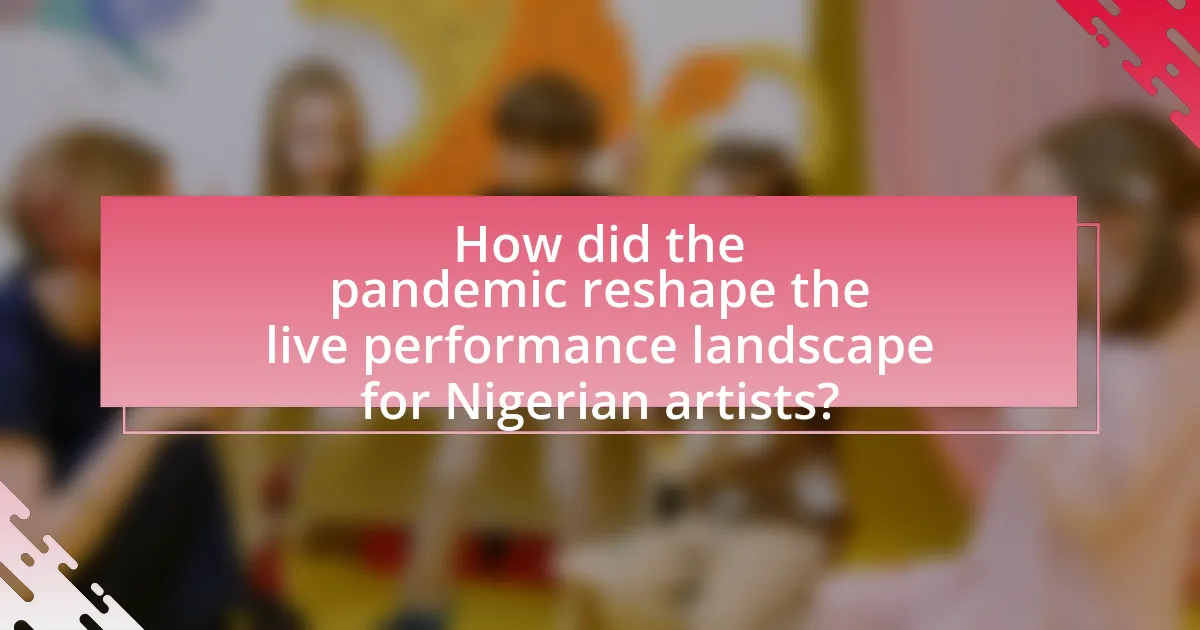
How did the pandemic reshape the live performance landscape for Nigerian artists?
The pandemic significantly reshaped the live performance landscape for Nigerian artists by accelerating the adoption of digital platforms for performances. With physical venues closed and social distancing measures in place, many artists turned to virtual concerts and live-streaming events to reach their audiences. For instance, in 2020, Nigerian artists like Burna Boy and Wizkid hosted online shows that attracted thousands of viewers globally, showcasing their work despite restrictions on in-person gatherings. This shift not only expanded their reach but also highlighted the importance of digital engagement in the music industry, leading to a lasting change in how performances are delivered and consumed.
What long-term changes can be observed in the industry?
Long-term changes observed in the live performance industry for Nigerian artists include a significant shift towards digital platforms and hybrid events. The COVID-19 pandemic accelerated the adoption of online streaming services, leading to artists increasingly utilizing platforms like YouTube and Instagram Live to reach audiences. According to a report by the Nigerian Entertainment Industry, 70% of artists have integrated digital performances into their strategies post-pandemic, indicating a permanent change in how performances are delivered. Additionally, there is a growing emphasis on health and safety protocols at live events, which has reshaped audience expectations and venue operations. This evolution reflects a broader trend towards innovation and adaptability in the industry, driven by the necessity of maintaining engagement during and after the pandemic.
How have audience expectations shifted post-pandemic?
Audience expectations have shifted post-pandemic towards a greater emphasis on safety, accessibility, and enhanced digital experiences. Audiences now prioritize health protocols at live events, seeking assurances such as social distancing and sanitation measures, which have become standard expectations. Additionally, the rise of virtual and hybrid events during the pandemic has led audiences to expect seamless integration of digital options, allowing for remote participation alongside in-person attendance. According to a survey by Eventbrite in 2021, 70% of respondents expressed a desire for events to continue offering virtual components even as in-person gatherings resume, highlighting a significant shift in how audiences engage with performances.
What new trends in performance formats have emerged?
New trends in performance formats that have emerged include hybrid events, which combine in-person and virtual experiences, and the use of live streaming to reach broader audiences. The COVID-19 pandemic accelerated the adoption of these formats, as artists sought to maintain engagement while adhering to social distancing measures. According to a report by the International Federation of the Phonographic Industry, 75% of artists reported using digital platforms for performances during the pandemic, highlighting a significant shift in how performances are delivered and consumed.
How did collaborations and community support evolve during the pandemic?
Collaborations and community support significantly evolved during the pandemic as artists and organizations adapted to restrictions on live performances. Many Nigerian artists turned to virtual platforms for collaboration, creating online concerts and music projects that reached wider audiences. For instance, the #EndSARS movement in Nigeria saw artists unite to raise awareness and funds through collaborative performances, demonstrating a shift towards collective action in response to social issues. Additionally, community support increased as fans and local businesses rallied to support artists through crowdfunding initiatives and merchandise sales, highlighting a strengthened bond between artists and their communities during challenging times.
What role did social media play in artist collaborations?
Social media significantly facilitated artist collaborations during the COVID-19 pandemic by providing a platform for remote interaction and creative exchange. Artists utilized social media channels like Instagram, Twitter, and TikTok to connect with each other, share ideas, and collaborate on projects without the need for physical presence. For instance, many Nigerian artists engaged in virtual performances and collaborative music projects, leveraging social media to reach wider audiences and maintain engagement during lockdowns. This shift not only allowed for innovative artistic expressions but also helped sustain the music industry by fostering new partnerships and collaborations that might not have occurred otherwise.
How did local communities support artists during lockdowns?
Local communities supported artists during lockdowns by organizing virtual events and fundraising initiatives. For instance, community members created online platforms to showcase artists’ work, allowing them to reach audiences despite physical restrictions. Additionally, initiatives such as crowdfunding campaigns and local grants provided financial assistance to artists facing economic hardships due to the pandemic. These efforts not only helped sustain artists’ livelihoods but also fostered a sense of solidarity and cultural connection within the community during a challenging time.

What are the future implications for live performances of Nigerian artists post-COVID-19?
The future implications for live performances of Nigerian artists post-COVID-19 include a significant shift towards hybrid events that combine in-person and virtual experiences. This adaptation allows artists to reach wider audiences beyond geographical limitations, as evidenced by the increased online engagement during the pandemic, where platforms like Instagram and YouTube became vital for performances. Additionally, enhanced health and safety protocols will likely become standard, influencing venue capacities and audience interactions. The Nigerian music industry has already seen a rise in digital ticketing and streaming revenue, indicating a permanent change in how performances are monetized and accessed.
How can Nigerian artists prepare for future disruptions?
Nigerian artists can prepare for future disruptions by diversifying their revenue streams and enhancing their digital presence. Diversification allows artists to reduce reliance on live performances, which can be affected by unforeseen events like pandemics. For instance, artists can explore merchandise sales, virtual concerts, and collaborations with brands to generate income. Enhancing digital presence through social media and streaming platforms enables artists to reach wider audiences and maintain engagement during disruptions. According to a report by the International Federation of the Phonographic Industry, digital music revenues grew by 19.9% in 2020, highlighting the importance of online platforms for artists’ sustainability.
What best practices can be adopted for hybrid performances?
Best practices for hybrid performances include ensuring high-quality audio and video production, engaging both in-person and virtual audiences, and utilizing interactive technology. High-quality production is essential as it enhances the viewing experience for remote participants, making them feel included. Engaging both audiences can be achieved through live polls, Q&A sessions, and social media interaction, which fosters a sense of community. Utilizing interactive technology, such as augmented reality or live streaming platforms, can bridge the gap between physical and virtual spaces, allowing for a seamless experience. These practices are supported by the increasing trend of hybrid events, which have shown to attract larger audiences and provide diverse engagement opportunities.
How can artists build resilience in their careers moving forward?
Artists can build resilience in their careers moving forward by diversifying their income streams and embracing digital platforms. Diversification allows artists to reduce reliance on live performances, which were significantly impacted by COVID-19, as evidenced by a 75% decline in live event revenues in 2020 according to the International Live Music Conference. By leveraging online platforms for virtual performances, merchandise sales, and crowdfunding, artists can create sustainable income sources. Additionally, developing skills in digital marketing and social media engagement enhances their visibility and connection with audiences, further supporting their resilience in an evolving industry landscape.
What lessons have been learned from the COVID-19 experience?
The COVID-19 experience has taught the importance of adaptability in the face of unforeseen challenges. Nigerian artists learned to pivot from traditional live performances to virtual platforms, which allowed them to reach wider audiences despite restrictions on gatherings. For instance, many artists utilized social media and streaming services to host online concerts, demonstrating resilience and innovation. This shift not only maintained audience engagement but also opened new revenue streams, highlighting the necessity for diversification in performance strategies.
How can the industry better support artists in crises?
The industry can better support artists in crises by implementing financial assistance programs and mental health resources tailored specifically for them. For instance, during the COVID-19 pandemic, many artists faced significant income loss due to canceled performances, highlighting the need for emergency funds and grants that can provide immediate relief. Research from the National Endowment for the Arts indicates that targeted financial support can help sustain artists during economic downturns, allowing them to focus on their craft rather than financial survival. Additionally, providing access to mental health services can address the psychological toll that crises impose on artists, as evidenced by studies showing increased rates of anxiety and depression in creative professionals during challenging times.
What strategies can enhance audience engagement in the future?
Utilizing interactive technology, such as augmented reality (AR) and virtual reality (VR), can significantly enhance audience engagement in the future. These technologies allow audiences to experience performances in immersive ways, creating a deeper emotional connection. For instance, a study by PwC found that 43% of consumers are interested in using AR and VR for live events, indicating a strong market potential. Additionally, incorporating real-time audience feedback through social media platforms can foster a sense of community and involvement, as evidenced by the increased engagement rates seen during live-streamed events where audience interaction was encouraged.
What practical steps can artists take to thrive in a post-pandemic world?
Artists can thrive in a post-pandemic world by diversifying their income streams and embracing digital platforms. This approach allows artists to reach wider audiences and mitigate the financial risks associated with live performances, which were heavily impacted during the pandemic. For instance, many artists have successfully transitioned to online concerts and virtual art exhibitions, generating revenue through ticket sales and merchandise. According to a report by the International Federation of the Phonographic Industry, global digital music revenues grew by 19.9% in 2020, highlighting the potential of digital avenues for artists. Additionally, artists should engage with their communities through social media and local collaborations, fostering support and building a loyal fan base. This strategy not only enhances visibility but also creates opportunities for partnerships and sponsorships, essential for sustaining their careers in a changing landscape.
